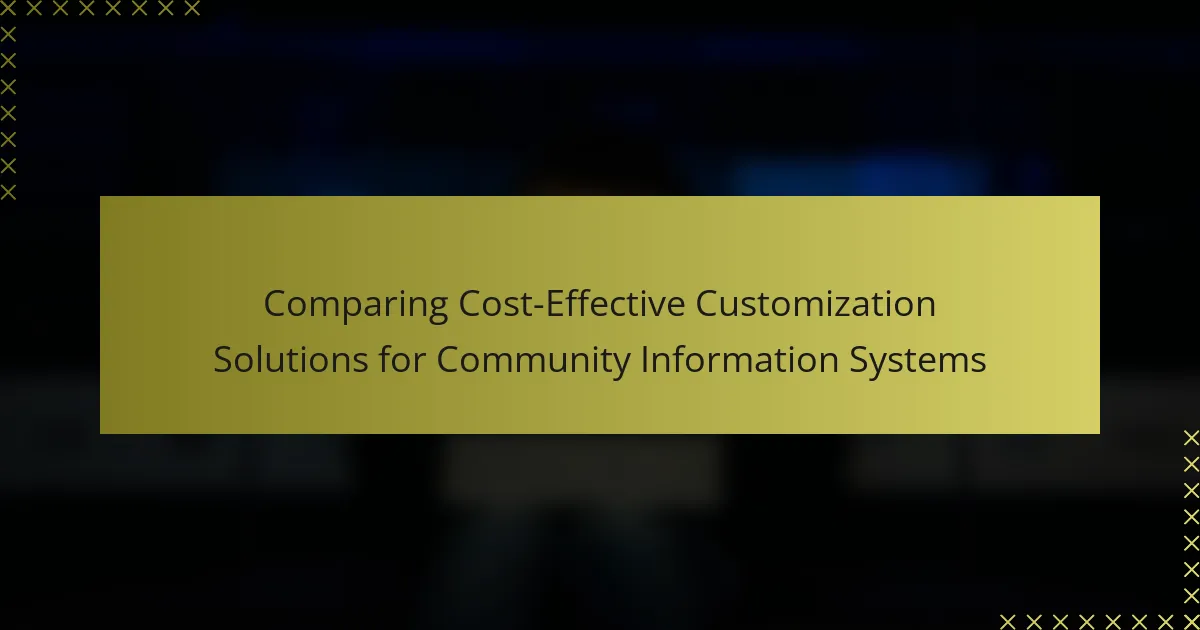In today’s digital landscape, cost-effective customization solutions for community information systems are essential for organizations looking to meet specific needs without overspending. Options such as open-source platforms, low-code development tools, and cloud-based services provide varying degrees of affordability and functionality, allowing for tailored implementations. When selecting a solution, it is crucial to consider factors like scalability, integration capabilities, and user experience to ensure long-term success and satisfaction.

What are the cost-effective customization solutions for community information systems?
Cost-effective customization solutions for community information systems include open-source platforms, low-code development tools, cloud-based services, and community-driven solutions. These options allow organizations to tailor their systems to meet specific needs while managing costs effectively.
Open-source platforms
Open-source platforms provide a flexible and cost-efficient way to customize community information systems. They allow users to modify the source code to fit their unique requirements without incurring licensing fees. Popular examples include Drupal and Joomla, which offer extensive plugins and community support.
When choosing an open-source solution, consider the technical expertise available within your team. While these platforms can be highly customizable, they may require significant development resources to implement and maintain.
Low-code development tools
Low-code development tools enable users to create applications with minimal coding, making them accessible for non-technical users. Platforms like Mendix and OutSystems allow for rapid development and iteration, which is ideal for community information systems that need to adapt quickly to changing needs.
These tools often come with pre-built templates and components, reducing development time. However, be aware of potential vendor lock-in and ensure that the platform can scale with your community’s growth.
Cloud-based services
Cloud-based services offer scalable and cost-effective solutions for community information systems, allowing organizations to pay for only what they use. Services like Amazon Web Services and Microsoft Azure provide infrastructure and tools that can be customized to meet specific community needs.
While cloud services can reduce upfront costs, consider ongoing expenses related to data storage and bandwidth. It’s essential to evaluate your community’s usage patterns to optimize costs effectively.
Community-driven solutions
Community-driven solutions leverage the collective knowledge and resources of community members to create tailored information systems. Platforms like Ushahidi allow users to report issues and share information, fostering collaboration and engagement.
When implementing community-driven solutions, ensure that there is a clear governance structure to manage contributions and maintain quality. Engaging community members in the development process can lead to more relevant and effective systems.

How do these solutions compare in pricing?
Cost-effective customization solutions for community information systems vary significantly in pricing, depending on the type of solution chosen. Open-source options typically have lower upfront costs but may require more resources for implementation, while low-code platforms offer a balance of affordability and ease of use, and cloud services provide scalable pricing based on usage.
Open-source cost analysis
Open-source solutions often come with no licensing fees, making them attractive for budget-conscious communities. However, organizations should consider potential costs for hosting, maintenance, and support, which can add up. For example, while software may be free, hiring developers for customization can lead to expenses in the low thousands of USD.
Communities should evaluate the total cost of ownership, including training and ongoing support. It’s essential to assess whether in-house expertise exists or if external consultants will be needed, which can significantly impact overall costs.
Low-code pricing models
Low-code platforms typically operate on a subscription basis, with pricing tiers that can range from affordable monthly fees to more expensive enterprise plans. These models often include features like user licenses, storage, and support, which can help organizations scale their solutions without incurring high initial costs.
When considering low-code options, communities should compare the features offered at different pricing levels to ensure they select a plan that meets their needs without overspending. Some platforms may offer free trials, allowing organizations to test functionality before committing financially.
Cloud service pricing tiers
Cloud services usually employ a pay-as-you-go pricing model, where costs are based on usage metrics such as data storage, bandwidth, and user access. This flexibility allows communities to manage their budgets effectively, scaling up or down as needed. Basic plans can start at low monthly fees, while more comprehensive solutions may cost significantly more.
Communities should carefully analyze their expected usage patterns to avoid unexpected charges. It’s advisable to review pricing calculators provided by cloud service providers to estimate costs accurately based on anticipated needs, ensuring that the chosen service aligns with budget constraints.

What are the key features to consider?
When evaluating cost-effective customization solutions for community information systems, focus on scalability, integration capabilities, and user experience design. These features significantly impact the system’s adaptability, functionality, and overall user satisfaction.
Scalability options
Scalability refers to a system’s ability to handle growth, whether in user numbers or data volume. Solutions should allow for easy upgrades or expansions without requiring a complete overhaul, which can be costly.
Consider platforms that offer tiered pricing models or modular components, enabling you to pay for only what you need initially and expand as your community grows. For instance, a system that supports adding new modules for additional features can be beneficial.
Integration capabilities
Integration capabilities determine how well a community information system can work with existing tools and platforms. Look for solutions that support standard APIs and data formats, facilitating seamless connections with other software.
Evaluate the ease of integration with popular tools like CRM systems or social media platforms. A system that can synchronize data across multiple channels can enhance functionality and improve user engagement.
User experience design
User experience design is crucial for ensuring that community members find the system intuitive and easy to navigate. A well-designed interface can significantly improve user satisfaction and reduce training time.
Prioritize solutions that offer customizable dashboards and user-friendly navigation. Conduct usability testing with a sample of your community to gather feedback on design elements, ensuring the system meets their needs effectively.

What are the benefits of using customization solutions?
Customization solutions offer tailored features that enhance the functionality and usability of community information systems. These benefits include improved user engagement, better data management, and long-term cost savings.
Enhanced user engagement
Customization solutions can significantly boost user engagement by allowing systems to be tailored to the specific needs and preferences of the community. Features such as personalized dashboards, targeted notifications, and user-friendly interfaces encourage active participation.
For example, a community portal that allows users to customize their experience can lead to higher interaction rates. Engaging users with relevant content and tools fosters a sense of ownership and connection to the platform.
Improved data management
Effective customization solutions enhance data management by integrating various data sources and streamlining workflows. This allows for better organization, analysis, and reporting of community data, which is crucial for informed decision-making.
Consider implementing a system that automatically categorizes and prioritizes data based on user-defined criteria. This not only saves time but also improves the accuracy of the information being utilized, leading to more effective community initiatives.
Cost savings over time
Investing in customization solutions can lead to significant cost savings over time by reducing the need for extensive training and support. Systems that are tailored to user needs often require less ongoing maintenance and can adapt more easily to changing requirements.
For instance, communities that adopt customizable platforms may find that they can operate with fewer resources, as users become more self-sufficient. This efficiency can translate into lower operational costs and a better allocation of budget resources for other community projects.

What are the challenges associated with these solutions?
Cost-effective customization solutions for community information systems face several challenges, including technical complexity, resource allocation, and user adoption. These factors can significantly impact the effectiveness and efficiency of the systems.
Technical expertise requirements
Implementing cost-effective customization solutions often requires a certain level of technical expertise. Organizations may need skilled personnel who understand the specific technologies and frameworks used in these systems.
For example, a community information system built on open-source platforms may necessitate knowledge of programming languages like Python or JavaScript. Without this expertise, organizations might struggle to customize or maintain their systems effectively.
To mitigate this challenge, consider investing in training for existing staff or collaborating with external consultants. This can help bridge the knowledge gap and ensure that the system meets community needs efficiently.



